|
Notes: Bolton Great Moor Street was the northern terminus of a 10½-mile line that connected to the Liverpool & Manchester Railway (L&M) of 1830 at Kenyon Junction. The Bolton & Leigh Railway (B&L) had been authorised to build an 8-mile line between Bolton and Leigh on 31 March 1825. They opened the first section between Bolton and Chequerbent for goods services only on 28 August 1828. The line had been engineered by George Stephenson and it was one of his locomotives, the Lancashire Witch that made the inaugural run. The section of line from Chequerbent to Leigh opened in March 1830. At Leigh the line connected to the Leeds & Liverpool canal, the original purpose having been to connect Bolton to the canal. The last 2½ miles of line, between Leigh and Kenyon Junction, was authorised on 14 May 1829 and was built by the Kenyon & Leigh Junction Railway (K&LJR). It opened to goods on 3 January 1831.
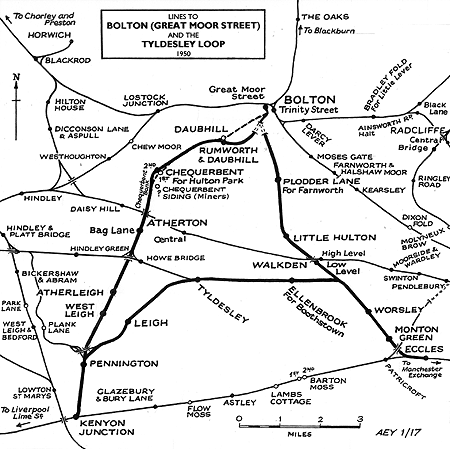 The first passenger train ran over the line on 2 June 1831, an excursion from Bolton to Newton for a horse racing event; full public services began on 13 June 1831. The first passenger train ran over the line on 2 June 1831, an excursion from Bolton to Newton for a horse racing event; full public services began on 13 June 1831.
The station at Bolton was located on the south side of Great Moor Street on the southern edge of the town’s commercial district. At the time of opening it was simply called Bolton. The station was quite basic having just a single platform protected from the elements by a trainshed.
More extensive goods facilities were located to the south of the passenger station at Crook Street.
At the time of opening there were two trains per day to and from Liverpool.
On 4 July 1837 the Grand Junction Railway (GJR) was opened between the L&M at Newton and Birmingham. This development meant that Bolton was connected to a trunk route, and following the opening of the London & Birmingham Railway (L&B) on 9 April 1838 the town in easy reach of the capital.
On 8 August 1845 the B&L was merged into the GJR (as were the L&M and the K&LJR). A year later, on 16 July 1846 the GJR merged with the L&B to form the London & North Western Railway (LNWR).
In October 1849 the station was renamed Bolton Great Moor Street to distinguish it from the recently opened Lancashire & Yorkshire Railway (LYR) station at Trinity Street.
The March 1850 timetable showed seven departures and eight arrivals on Monday-to-Saturday.
On 28 January 1858 a goods train consisting of 32 wagons ran away on the Daubhill incline and crashed into Great Moor Street station demolishing it. One man was killed. The station was patched up and brought back into use.
On 29 May 1838 the Manchester, Bolton & Bury Canal Navigation Railway (absorbed into the Lancashire & Yorkshire Railway on 9 July 1847) had opened a line between Manchester and Bolton and it had been extended north and west by the 1850s linking Bolton to Liverpool and to Preston. These lines of the Lancashire & Yorkshire Railway (LYR) competed with the LNWR services. The LNWR was at a particular disadvantage with regard to Manchester traffic. Passengers wanting to reach Manchester from Great Moor Street had to travel via Kenyon Junction. The LYR route from Bolton Trinity Street was direct and therefore a far better option. In order to compete effectively for Manchester traffic the LNWR obtained an Act in 1865 which authorised a new line between Roe Green Junction (on the LNWR direct line between Eccles and Wigan) and Bolton Great Moor Street.
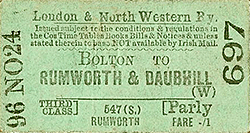 In 1869, during the construction of the Manchester line, the LNWR obtained a further Act which authorised the building of a new station at Great Moor Street. On 1 August 1871 the LNWR closed the original Bolton Great Moor Street station to rebuild it on a grander scale. Temporary passenger facilities were opened at the Crook Street Goods Station. The new Great Moor Street station opened on 28 September 1874 on the same site as the original but it was much larger and at a 10ft higher elevation. In 1869, during the construction of the Manchester line, the LNWR obtained a further Act which authorised the building of a new station at Great Moor Street. On 1 August 1871 the LNWR closed the original Bolton Great Moor Street station to rebuild it on a grander scale. Temporary passenger facilities were opened at the Crook Street Goods Station. The new Great Moor Street station opened on 28 September 1874 on the same site as the original but it was much larger and at a 10ft higher elevation.
The station frontage was a hybrid of Classical and Gothic styles. The two-storey structure was brick-built and gables given the appearance of pediments corresponded to the entrances. Upper floor openings were rectangular, but on the ground floor they were given shallow pointed arches highlighted by stone dressings to complement the ridge-and-furrow awning.
The station and its approaches were on a viaduct and it consisted of four platform faces of 300ft length. They were sheltered by a trainshed and provided with extensive waiting facilities.
The LNWR Manchester line opened on 1 April 1875 and from that day direct services between Bolton Great Moor Street and Manchester Victoria were introduced. Two trains per day in each direction also linked Bolton to London Euston. Manchester services used the two platforms on the east side of the station and those to Kenyon Junction departed from the west side.
Further Acts of 1878 and 1880 authorised improvements to the original B&L line. The steeply-graded banks at Chequerbent and Daubhill were eased by the creation of deviation lines and the line was doubled (Atherton Junction – Pennington Junction on 31 May 1880, through Atherton station 4 July 1880 and Atherton – Bolton on 2 Feb 1885).
On 30 June 1884 services from Great Moor Street were diverted to the new LNWR station called Manchester Exchange. During the latter part of the nineteenth century Great Moor Street station had regular services both to Manchester and to Kenyon Junction (from where some services ran on to Warrington or Liverpool). The station also enjoyed express services to destinations further afield including Euston.
On 1 January 1922 the LYR was absorbed into the LNWR and a year later on 1 January 1923 the LNWR became part of the London, Midland & Scottish Railway (LMS). The LMS concentrated its main line passenger traffic onto the former LYR lines at Bolton Trinity Street but Great Moor Street did retain some express workings especially during the summer months when holiday trains were run to destinations on the North Wales coast. Under the LMS an intensive local service was operated from Great Moor Street and by the mid 1930s over 20 services operated along the Kenyon Junction line with fewer, but still significant, services running along the Manchester line.
By 1945 the station trainshed roof had been reduced to only a short section at the north end of the platforms.
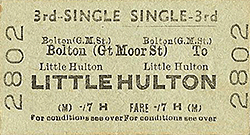 After nationalisation in 1948, in which Great Moor Street became part of British Railways (BR) London Midland Region (LMR), the value of having two lines from Manchester to Bolton was questioned. The Great Moor Street service took longer than the ex -L&Y route. By 1954 only four trains per day operated towards Manchester. The service on the Kenyon line had also declined in frequency and only six trains operated to either Kenyon Junction or Warrington. Regular services operating out of Bolton Great Moor Street ended on 27 March 1954. The last train to depart from the station was the 10.35pm to Kenyon Junction. After nationalisation in 1948, in which Great Moor Street became part of British Railways (BR) London Midland Region (LMR), the value of having two lines from Manchester to Bolton was questioned. The Great Moor Street service took longer than the ex -L&Y route. By 1954 only four trains per day operated towards Manchester. The service on the Kenyon line had also declined in frequency and only six trains operated to either Kenyon Junction or Warrington. Regular services operating out of Bolton Great Moor Street ended on 27 March 1954. The last train to depart from the station was the 10.35pm to Kenyon Junction.
BR(LMR) closed Bolton Great Moor Street to regular passenger services on 29 March 1954. An unadvertised workman’s service to Monton Green continued to run for a few months. The station continued to be used for summer holiday specials. On 28 June 1958 there were nine holiday special departures, the first being a train for Bangor at 6.25am. The last departure was at 1.30pm, being a train for Llandudno. This was the last year that the holiday trains ran.
On 21 September 1963 the South Lancashire Ltd rail tour ran to Bolton Great Moor Street and was the last passenger train to visit the station. Because of the condition of the track at the station it stopped on the south side of the Crook Street bridge and the passengers walked the final few yards up to the platforms.
The coal drops at Great Moor Street were used until 1964 after which the track was cut back to Crook Street. On 25 April 1965 Crook Street Goods closed to public services with private traffic ending on 16 October 1967.
Bolton Great Moor Street station was demolished in 1966 and replaced with a leisure pool which was itself demolished in 2003. Today there are no traces of the station and the site has been redeveloped as a petrol station and supermarket car park.
Click here to read about passenger train services
Tickets from Michael Stewart route map by Alan Young.
Sources:
- A Lancashire Triangle Part 2 - D J Sweeney, Triangle Publishing 1997.
- A Regional History of the Railways of Great Britain - Volume 10 The North West - Geoffrey O Holt, David & Charles 1986.
- Forgotten Railways - North West England - John Marshall, David & Charles 1981.
- Railway Passenger Stations in Great Britain - A Chronology, by M Quick, RCHS 2009.
- Railway Stations in the North West - Gordon Biddle, Dalesman Books 1981.
See also: The Bolton & Leigh Railway
See also: Bolton Crook Street Goods and Bolton Deansgate Goods
To see the other
stations on the Bolton Great Moor Street - Kenyon Junction line
click on the station name: Kenyon
Junction, Pennington,
West Leigh, Atherleigh,
Atherton Bag Lane,
Chequerbent 1st,
Chequerbent 2nd,
Daubhill 1st &
Rumworth
& Daubhill
To see the other stations on the Bolton Great Moor Street - Eccles line click on the station name: Plodder Lane for Farnworth, Little Hulton, Walkden Low Level, Worsley and Monton Green |

old1.jpg)
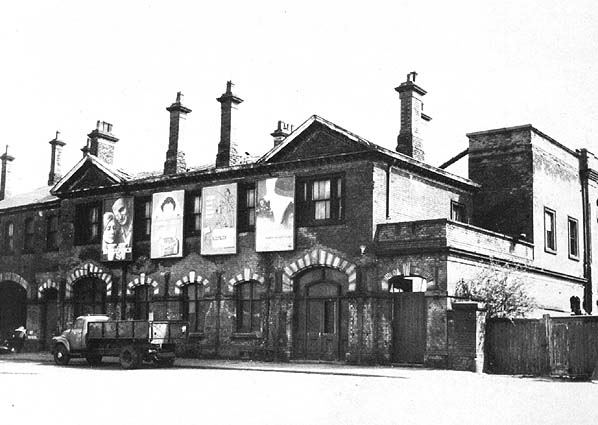
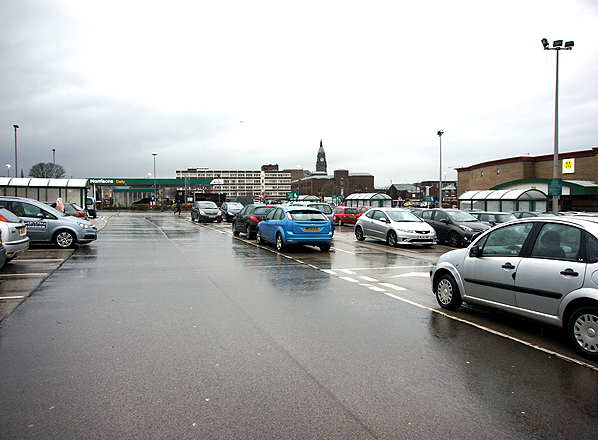
 Home
Page
Home
Page
 The first passenger train ran over the line on 2 June 1831, an excursion from Bolton to Newton for a horse racing event; full public services began on 13 June 1831.
The first passenger train ran over the line on 2 June 1831, an excursion from Bolton to Newton for a horse racing event; full public services began on 13 June 1831. In 1869, during the construction of the Manchester line, the LNWR obtained a further Act which authorised the building of a new station at Great Moor Street. On 1 August 1871 the LNWR closed the original Bolton Great Moor Street station to rebuild it on a grander scale. Temporary passenger facilities were opened at the Crook Street Goods Station. The new Great Moor Street station opened on 28 September 1874 on the same site as the original but it was much larger and at a 10ft higher elevation.
In 1869, during the construction of the Manchester line, the LNWR obtained a further Act which authorised the building of a new station at Great Moor Street. On 1 August 1871 the LNWR closed the original Bolton Great Moor Street station to rebuild it on a grander scale. Temporary passenger facilities were opened at the Crook Street Goods Station. The new Great Moor Street station opened on 28 September 1874 on the same site as the original but it was much larger and at a 10ft higher elevation.  After nationalisation in 1948, in which Great Moor Street became part of British Railways (BR) London Midland Region (LMR), the value of having two lines from Manchester to Bolton was questioned. The Great Moor Street service took longer than the ex -L&Y route. By 1954 only four trains per day operated towards Manchester. The service on the Kenyon line had also declined in frequency and only six trains operated to either Kenyon Junction or Warrington. Regular services operating out of Bolton Great Moor Street ended on 27 March 1954. The last train to depart from the station was the 10.35pm to Kenyon Junction.
After nationalisation in 1948, in which Great Moor Street became part of British Railways (BR) London Midland Region (LMR), the value of having two lines from Manchester to Bolton was questioned. The Great Moor Street service took longer than the ex -L&Y route. By 1954 only four trains per day operated towards Manchester. The service on the Kenyon line had also declined in frequency and only six trains operated to either Kenyon Junction or Warrington. Regular services operating out of Bolton Great Moor Street ended on 27 March 1954. The last train to depart from the station was the 10.35pm to Kenyon Junction. .jpg)
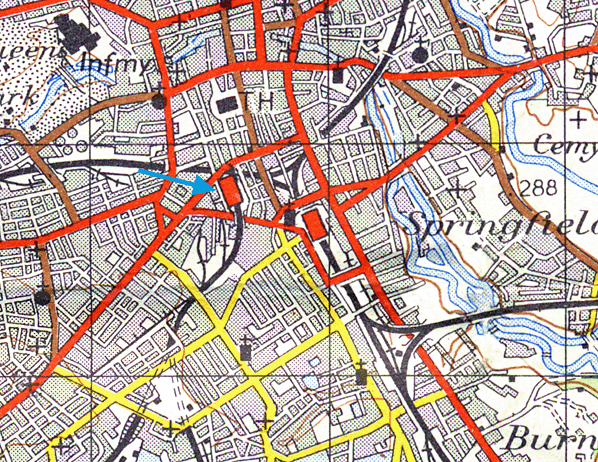
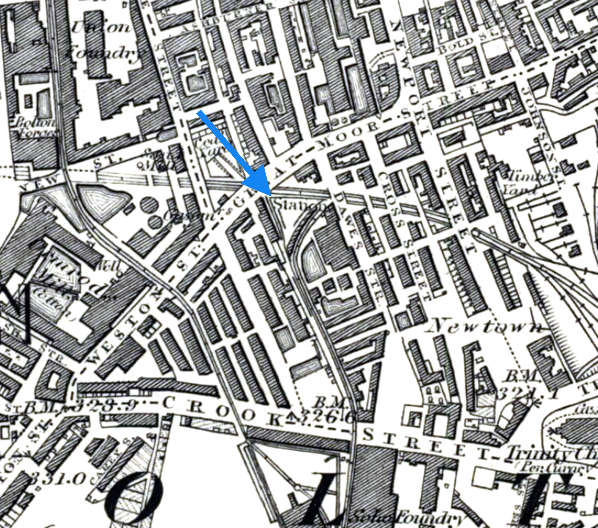
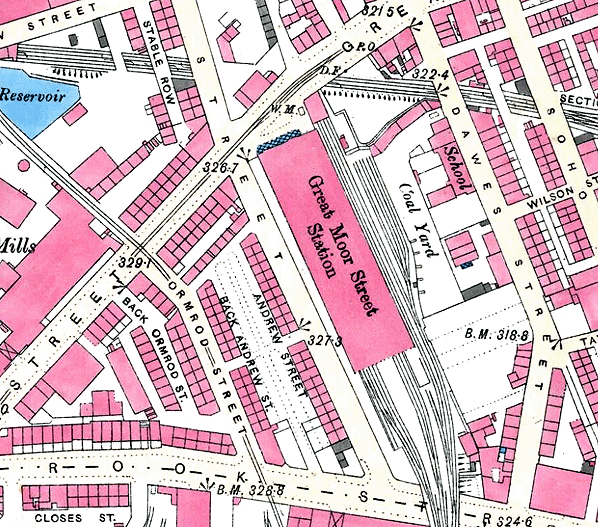
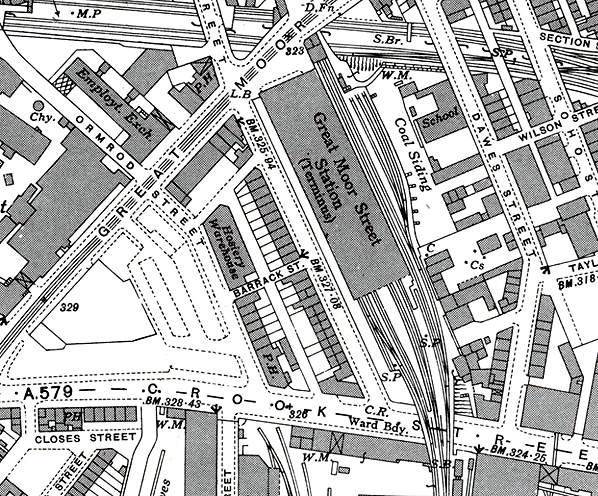
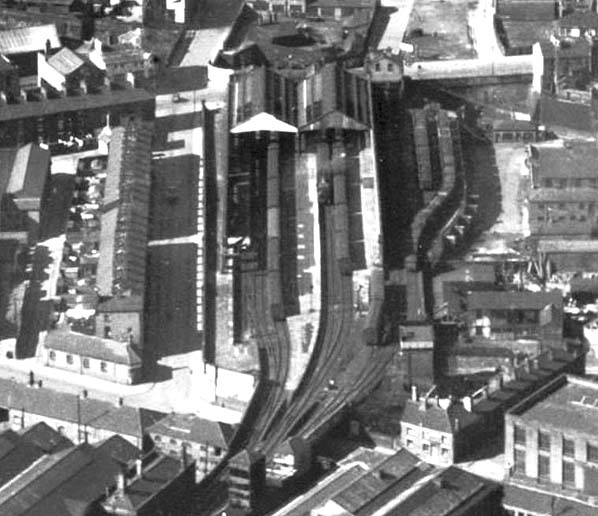
.jpg)
.jpg)
